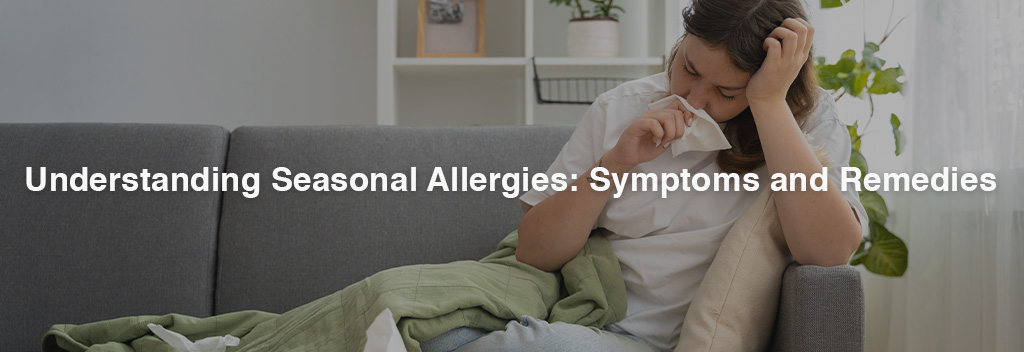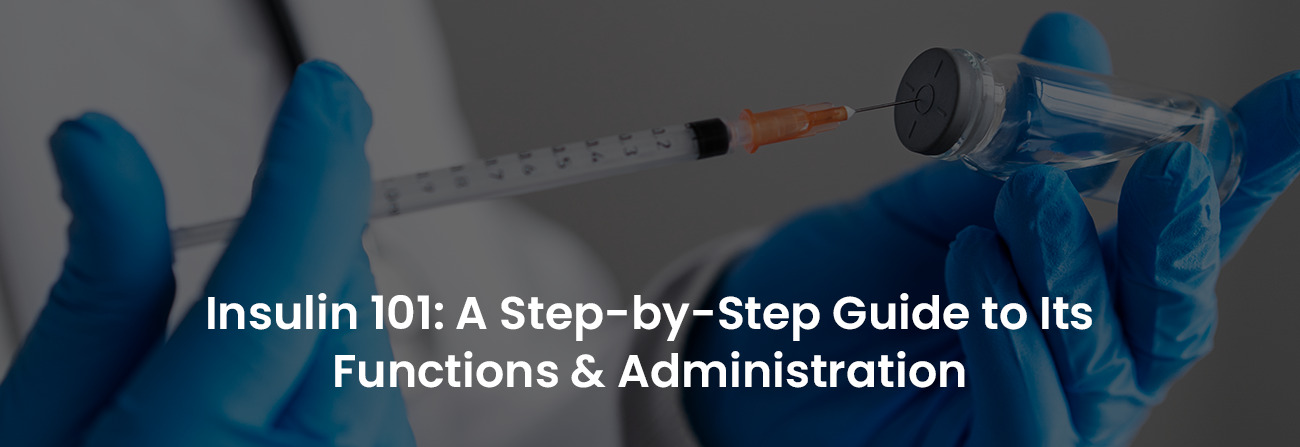
An often overlooked but critically important issue in the elderly is anemia. As the population ages, understanding and addressing anemia becomes increasingly crucial for maintaining their health and quality of life. Anemia is a medical condition characterized by a reduced number of red blood cells or a decrease in hemoglobin in the blood. Hemoglobin is the protein responsible for transporting oxygen from the lungs to various body parts. When anemia occurs, the body may not receive enough oxygen, leading to various health issues.
Prevalence in Older Adults
Anemia isn’t restricted to any specific age group; its prevalence significantly increases among older adults. The body undergoes various changes with age, some of which can contribute to anemia. These changes can include reduced red blood cell production, nutritional deficiencies, and a higher likelihood of chronic illnesses.
Causes of Anemia in Older Adults
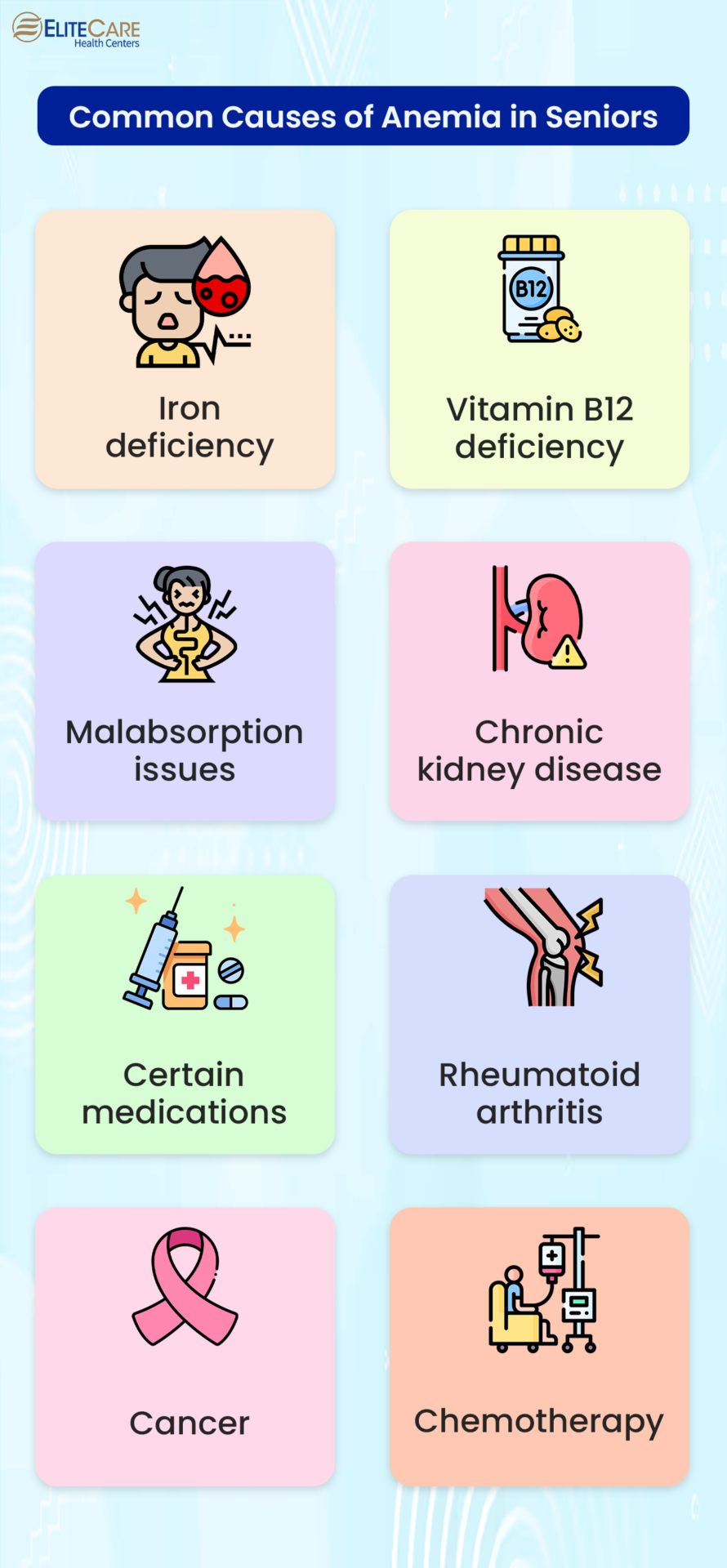
When it comes to anemia in elderly, numerous complex factors are at play. Nutritional deficiency and chronic issues often result in anemia. According to the National Council of Aging nearly 95% of adults 60 and older have at least one chronic condition. The most common causes of anemia in seniors are as follows:
- Iron Deficiency
- Vitamin B12 Deficiency
- Malabsorption Issues
- Chronic kidney disease
- Cancer
- Rheumatoid arthritis
- Certain medications
- Medical treatments such as chemotherapy
Symptoms
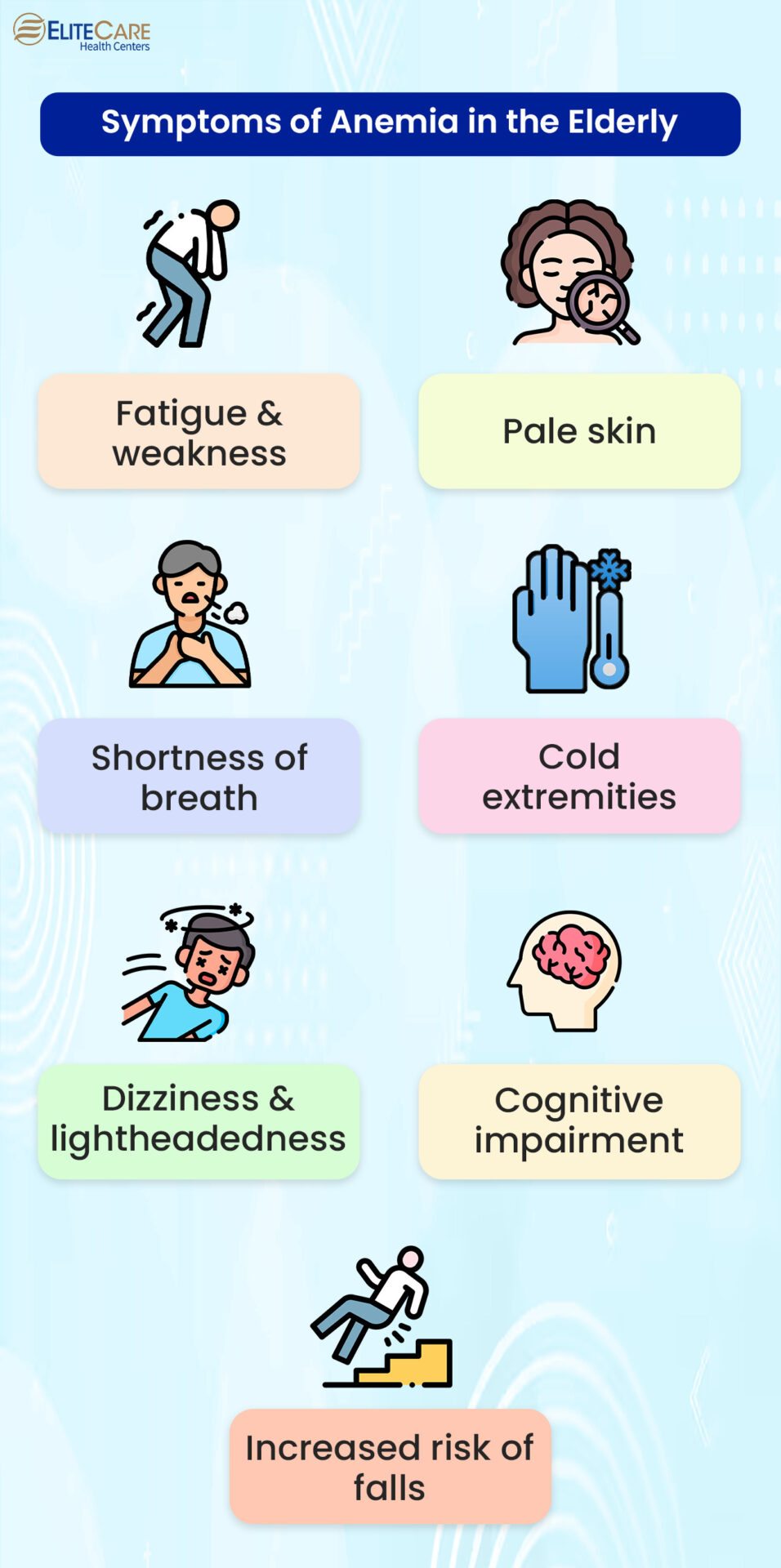
Anemia in older adults can manifest with many symptoms, which may be mistaken for typical signs of aging. Recognizing these signs is essential for both seniors themselves and their caregivers. The most common symptoms of anemia in older adults are as follows:
1. Fatigue and Weakness
Seniors with anemia often experience profound fatigue and weakness, making routine activities more challenging.
2. Pale Skin and Mucous Membranes
Anemia can lead to paleness of the skin and mucous membranes, such as the mouth’s inside and the eyes’ conjunctiva. This pallor is a result of reduced red blood cell and hemoglobin levels.
3. Shortness of Breath
This is due to the reduced oxygen-carrying capacity of their blood, making physical activities more taxing.
4. Cold Extremities
Anemia can result in reduced blood circulation, causing seniors to experience coldness in their hands and feet. This discomfort or sensation of coldness in extremities is due to inadequate supply of oxygen.
5. Dizziness and Lightheadedness
Anemia can cause a drop in blood pressure, leading to dizziness and lightheadedness, especially when changing positions, such as getting up from a seated or lying position.
6. Cognitive Impairment
Memory problems, difficulty concentrating, and a sense of mental “fogginess” may occur due to anemia.
7. Increased Risk of Falls
Anemia-related fatigue, weakness, and dizziness can significantly increase the risk of falls in older adults. Falls can result in serious injuries, such as fractures, further complicating their health.
It is advisable to seek medical attention promptly. Senior care services, including visits to a medical clinic or health care center, are essential in the diagnostic process. Consultation with a primary care physician specializing in geriatric health can be particularly beneficial as they are well-equipped to address the unique needs of older individuals.
Diagnosis and Evaluation
It’s estimated that over 17% of individuals over 65 are affected by anemia. Accurate diagnosis is crucial for effective management and improving older adult’s overall health. Healthcare professionals utilize various diagnostic methods to assess and pinpoint the underlying causes of anemia, such as:
1. Blood Tests
- Hemoglobin: Measurement of hemoglobin levels is a fundamental step in diagnosing anemia. Low hemoglobin levels are indicative of anemia.
- Hematocrit: Hematocrit assesses the percentage of red blood cells in the bloodstream. A diminished hematocrit level serves as an additional indicator of anemia.
- Red Blood Cell Count: A complete blood count (CBC) assesses the number of red blood cells present. A decreased red blood cell count suggests anemia.
2. Additional Tests to Determine Underlying Causes
- Iron Studies: Iron studies, including serum iron, ferritin, and total iron-binding capacity (TIBC), can help identify iron deficiency as a cause of anemia.
- Vitamin B12 and Folate Levels: Measuring vitamin B12 and folate levels in the blood is crucial, as deficiencies in these vitamins can lead to anemia.
3. Medical History and Physical Examination
A comprehensive medical history and a thorough annual physical examination are essential in diagnosing anemia. The healthcare provider will inquire about the patient’s symptoms, past medical conditions, medications, and dietary habits.
4. Importance of Ruling Out Serious Underlying Conditions
This includes investigating chronic diseases or autoimmune disorders. Identifying and addressing these underlying conditions is critical for effective management.
Online doctor consultations can also be convenient and accessible for older adults to discuss their symptoms and receive guidance on further diagnostic steps.
Treatment Options
Effective treatment strategies for anemia in the elderly are as follows:
1. Iron Supplementation
Oral iron supplements may be prescribed to increase iron levels and stimulate red blood cell production. In cases where oral iron is ineffective or cannot be tolerated, healthcare providers may administer iron intravenously. This method can provide a more rapid increase in iron levels and is particularly useful for seniors with absorption issues.
2. Vitamin B12 & Folate Supplementation
Supplements can be administered orally or via injections depending on the severity of the deficiency.
3. Managing Underlying Chronic Conditions
Treating and managing underlying chronic conditions is essential to address the root causes of anemia. This may involve specialized care from Elite healthcare institutions or health centers near you.
4. Medication Adjustments
If medications or treatments (e.g., chemotherapy, NSAIDs) are contributing to anemia, healthcare providers may adjust or modify the dosage or switch to alternative medications that are less likely to cause anemia.
5. Dietary Changes and Nutrition Counseling
Elite Health and Wellness Centers may offer specialized nutrition counseling to address anemia through dietary adjustments. Ensuring an older adult’s diet is rich in iron, vitamin B12, and folate can be an effective long-term strategy.
6. Potential Need for Blood Transfusions
In severe cases of anemia or rapid correction, blood transfusions may be necessary. This procedure involves a donor’s infusion of red blood cells to improve oxygen-carrying capacity.
The choice of treatment depends on the type and underlying causes. Older adults must collaborate closely with their healthcare providers, primary care physicians, and Elite Medical Centers specializing in senior care services.
Prevention and Lifestyle Recommendations
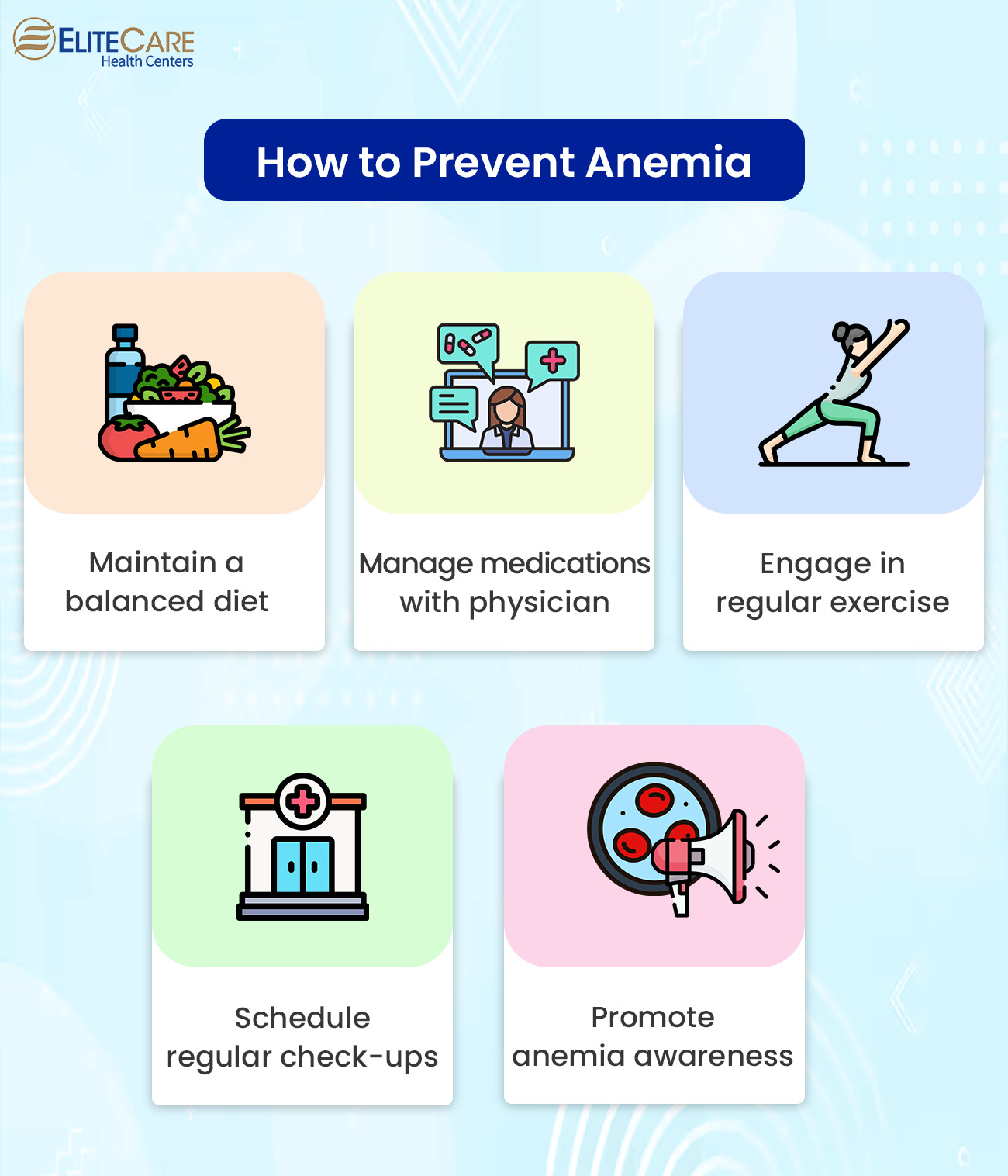
Preventing anemia and maintaining their overall health involves a combination of lifestyle choices and proactive measures. Some valuable recommendations are as follows:
1. Balanced Diet
Nutritional deficiencies are more likely to occur when diet choices are limited. Seniors should consume foods rich in iron and vitamin B12, such as lean meats, poultry, fish, beans, lentils, fortified cereals, dark leafy greens, eggs, dairy, and folate-rich foods like beans and spinach in their diet.
2. Medication Management
Seniors should communicate openly with their healthcare providers about their medications. This helps identify potential drug-induced anemia early, allowing medication adjustments or alternatives to be considered.
3. Exercise and Physical Activity
Regular physical activity, within a senior’s capability, can enhance circulation, muscle strength, and overall vitality. It can also promote better appetite and digestion, aiding in nutrient absorption. Walking, swimming, or gentle yoga can benefit older adults.
4. Regular Medical Check-Ups
Stress the importance of regular medical check-ups with a physician or geriatric specialist. Routine blood tests as part of a annual physical exam can detect changes in hemoglobin, hematocrit, or red blood cell counts, allowing for timely intervention.
5. Raising Awareness About Anemia in Older Adults
Community initiatives, support groups, and healthcare organizations can raise awareness about anemia and the importance of early detection and treatment.
To Sum Up
Recognizing the signs and symptoms, seeking regular medical check-ups, and actively engaging in preventative measures can make a substantial difference. EliteCare Health Centers stand as a valuable resource for seniors. Our centers are equipped with top-tier medical professionals and specialized services to provide comprehensive care and support for seniors with anemia and other health issues.
It is always possible to take control of one’s health. Through awareness, education, and collaboration with healthcare professionals, seniors can manage anemia and embrace a healthy and active life.




